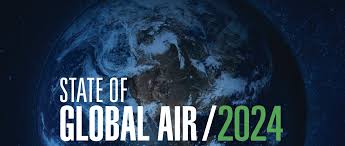- Courses
- GS Full Course 1 Year
- GS Full Course 2 Year
- GS Full Course 3 Year
- GS Full Course Till Selection
- Answer Alpha: Mains 2025 Mentorship
- MEP (Mains Enrichment Programme) Data, Facts
- Essay Target – 150+ Marks
- Online Program
- GS Recorded Course
- Polity
- Geography
- Economy
- Ancient, Medieval and Art & Culture AMAC
- Modern India, Post Independence & World History
- Environment
- Governance
- Science & Technology
- International Relations and Internal Security
- Disaster Management
- Ethics
- NCERT Current Affairs
- Indian Society and Social Issue
- NCERT- Science and Technology
- NCERT - Geography
- NCERT - Ancient History
- NCERT- World History
- NCERT Modern History
- CSAT
- 5 LAYERED ARJUNA Mentorship
- Public Administration Optional
- ABOUT US
- OUR TOPPERS
- TEST SERIES
- FREE STUDY MATERIAL
- VIDEOS
- CONTACT US
State of the Global Climate 2024-WMO
State of the Global Climate 2024-WMO

Introduction
- The State of the Global Climate 2024 report by the World Meteorological Organization (WMO) reveals alarming evidence of accelerating climate impacts. Global temperatures reached unprecedented levels, sea levels rose significantly, greenhouse gases hit record concentrations, and extreme weather intensified globally.
- This report emphasizes urgent global collaboration, enhanced climate resilience, and rapid emission reductions to protect humanity and ecosystems from increasingly severe climate-related threats.
Key Highlights of the report
1. Greenhouse Gas Concentrations
In 2023, atmospheric concentrations of the three main greenhouse gases – carbon dioxide (CO2), methane (CH4), and nitrous oxide (N2O) – reached their highest levels in at least 800,000 years continuing to increase throughout 2024.
- Carbon dioxide reached 420 ppm in 2023, approximately 151% of pre-industrial levels from the year 1750.
- Methane (CH₄) levels rose to 1,934 ppb, about 265% higher than pre-industrial values.
- Nitrous oxide (N₂O) concentrations increased to 337 ppb, representing about 125% of pre-industrial levels.

2. Global Temperature Records
Global temperatures continue to break historical records, underscoring rapid and sustained climate warming.
- The year 2024 was the warmest ever recorded in the 175-year history of temperature observations.
- Global mean temperature in 2024 was about 1.55°C above the 1850–1900 average baseline.
- Each year from 2015–2024 individually ranks among the ten warmest years on record.
- The significant temperature increase was boosted by a strong El Niño event at the beginning of 2024
3. Ocean Heat Content
The rate of ocean warming has accelerated: the oceans warmed more than twice as fast in 2005–2024 as they did in 1960–2005, reflecting unparalleled heat accumulation in the upper 2000 m of the ocean
- Global ocean heat content in 2024 reached the highest recorded level in the past 65 years.
- Each of the past eight years (2017-2024) set new records for ocean heat levels.
- Around 90% of Earth's surplus energy accumulates in oceans, profoundly affecting marine ecosystems globally
4. Global Mean Sea Level Rise
Sea-level rise has accelerated significantly, doubling the rate observed in earlier decades, threatening coastal regions worldwide.
- Global mean sea level in 2024 reached the highest-ever recorded level (satellite measurements since 1993).
- Rate of sea-level rise (4.7 mm/year) during 2015–2024 was more than double the rate from 1993–2002 (2.1 mm/year)
- This rise results from ocean thermal expansion and increased melting of glaciers and ice sheets.
5. Ocean Acidification
Ocean surface acidification has steadily increased, posing severe risks to marine biodiversity, fisheries, and ecosystems.
- Global ocean surface pH decreased(indicating increasing acidity) consistently at a rate of 0.017 pH units per decade from 1985–2023.
- This steady decline in pH is consistent with increased CO2 absorption by the oceans
- Regional acidification rates are uneven, with the Indian Ocean, Southern Ocean, and Pacific Ocean regions are acidifying faster than the global average.
- Acidification threatens marine organisms such as coral reefs, mollusks, and plankton, vital for ecosystem stability.
6. Glacier Mass Balance
Global glaciers continue to experience significant and accelerating mass loss, severely impacting freshwater resources.
- 2021/22–2023/24 represents the most negative three-year glacier mass balance ever recorded.
- Seven of the ten worst annual glacier mass balance losses since 1950 occurred since 2016, highlighting recent rapid acceleration.
- Exceptionally negative glacier mass balances observed in regions including Norway, Sweden, Svalbard, and the tropical Andes.
7. Sea-Ice Extent
Arctic and Antarctic sea-ice extents have significantly declined, marking persistent trends indicative of broader environmental shifts.
- The summer minimum daily Arctic sea-ice extent in 2024 was the 7th lowest on record (satellite observations since 1979), continuing a long-term shrinking trend
- The past 18 years consecutively account for the 18 lowest Arctic minimum ice extents ever observed.
- In the Antarctic, sea-ice extent reached extraordinarily low values: the annual maximum and minimum extents in 2024 were each the second-lowest ever recorded.
- For a third consecutive year the Antarctic winter sea-ice minimum fell below 2 million km², far below the long-term average, indicating a significant departure from typical conditions
Major Impacts of Climate Change
1. Climate-Induced Displacement
Extreme weather in 2024 led to unprecedented global displacement, significantly exacerbating humanitarian crises worldwide.
- 2024 recorded the highest annual number of climate-related displacements since consistent tracking began in 2008.
- Severe storms, floods, and wildfires displaced millions, disproportionately affecting vulnerable and conflict-impacted communities.
- Successive extreme events undermined societal resilience and increased humanitarian needs, particularly in fragile regions(for example, storms following drought).
2. Rising Food Insecurity
Climate extremes in 2024 exacerbated global hunger, highlighting critical vulnerabilities in food production systems.
- At least 18 countries faced severe and worsening food crises driven by drought, flooding, and climate extremes.
- At least 8 countries had 1 million or more additional people facing acute food insecurity compared to the previous year’s peak, largely due to prolonged drought conditions linked in some regions to El Niño.
- Global cereal harvests sharply declined due to droughts intensified by El Niño conditions, exacerbating global food shortages.(notably in parts of Africa and South America)
These trends highlight how climate change is intensifying food supply risks and humanitarian emergencies.
3. Inadequate Early Warning Systems
Inadequate global coverage of multi-hazard early warning systems left many vulnerable to climate extremes.
- Only about half of all countries currently have adequate early warning systems for climate hazards.
- Billions of people remain without sufficient protection against severe weather events, especially in developing nations.
4. High-Impact Tropical Cyclones
2024 was marked by high-impact tropical cyclones across multiple basins, causing loss of life and massive economic damage.
- Typhoon Yagi struck Southeast Asia, making landfall in Viet Nam affecting Philippines, China, Laos, Thailand, and Myanmar, causing massive displacement and damage.
- Cyclone Chido hit the southwest Indian Ocean region, striking Mayotte, in December displaced about 100,000 people in Mozambique and severely impacted Malawi and Mayotte.
- Hurricanes Helene and Milton struck Florida, USA; Helene caused over 200 deaths, marking the deadliest U.S. hurricane since 2005, and resulted in tens of billions in damages.
5. Devastating Wildfires and Severe Droughts
Wildfires and droughts escalated in severity, destroying ecosystems, homes, and leading to significant human and economic losses.
- Wildfire in Viña del Mar, Chile, February 2024, caused over 300 deaths and extensive property damage which is among the among the most severe wildfire losses globally in the 21st century
- Canada experienced its second-highest wildfire emissions; the USA also faced extreme wildfires, collectively displacing over 300,000 people.
- In the Amazon Basin, prolonged drought contributed to the highest number of fires observed in the Brazilian Amazon since 2010.
- Drought severely impacted agricultural productivity and water availability in regions like southern Africa, Mexico, Brazil, and other parts of South America.
6. Compound Climate Extremes
Multiple simultaneous climate disasters highlighted how climate extremes compound, overwhelming local response capacities.
- Afghanistan, Pakistan, and Iran experienced abnormal winter snowfall followed by destructive spring floods, resulting in significant fatalities and agricultural losses.
- Severe flash floods in Valencia, Spain, in October caused over 200 deaths, major infrastructure damage, and agricultural impacts.
- Historically low river water levels in South America (e.g., Paraguay River) severely disrupted energy generation, transport, and water security.
Way Forward: Climate Response Strategies
1. Accelerate Emissions Reductions
- Immediately reduce greenhouse gas emissions significantly to avoid exceeding 1.5°C warming (2024 temperatures were already 1.55°C above pre-industrial levels).
- Strengthen commitments under the Paris Agreement to reach global net-zero CO₂ emissions by mid-century.
- Prioritize rapid transition to renewable energy sources (solar, wind, hydropower).
- Halt global deforestation and expand reforestation efforts to enhance carbon absorption.
2. Enhance Early Warning Systems and Adaptation
- Invest globally to establish comprehensive multi-hazard early warning systems (currently, only half of countries have adequate systems).
- Strengthen National Meteorological and Hydrological Services for accurate, timely alerts (e.g., for events like Typhoon Yagi, Cyclone Chido).
- Build resilient infrastructure (flood defenses, storm shelters) and adopt climate-smart agriculture and water conservation to reduce climate impacts.
3. Increase Climate Finance and Support
- Significantly boost international climate finance, targeting vulnerable nations severely impacted by events such as floods in African Sahel and wildfires in Chile (300+ deaths).
- Fund resilient infrastructure projects (e.g., drought-resistant water systems, flood defenses) and ecosystem-based adaptation (e.g., mangrove restoration).
- Strengthen global cooperation ensuring equitable adaptation, improved emergency preparedness, and technological support.
4. Leverage Science for Informed Policy
- Base climate policies firmly on authoritative scientific assessments like WMO’s State of the Global Climate report.
- Integrate climate risk into urban planning, public health, agriculture, and disaster management strategies (e.g., addressing severe drought impacts in Amazon Basin and southern Africa).
- Educate stakeholders and public on climate science to build support for transformative actions.
Conclusion
The State of the Global Climate 2024 report highlights rapid and far-reaching impacts of climate change globally. Key indicators—record temperatures, greenhouse gas concentrations, rising sea levels, melting ice, and extreme weather—underline the urgency of climate action. Although the window for limiting warming is narrowing, immediate and coordinated global efforts, combining aggressive emissions mitigation, strengthened adaptation, and enhanced early warning systems, can avert the worst outcomes and secure a sustainable future.
About the World Meteorological Organization (WMO)
|
|
Also Read |
|
| Public Administration Optional | |
| UPSC Monthly Magazine | Question Answer Practice For UPSC |




